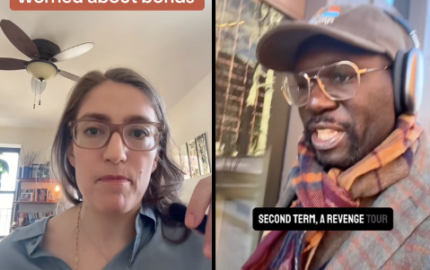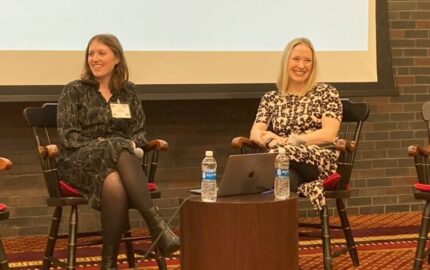As editor of the Virginia Quarterly Review, you’ve been making use of poets as reporters for a while. When did you start, and why?
I guess it started semi-formally by sending poets out to do nonfiction pieces. There are a fair number of poets who understand that poetry is not a livelihood and supplement their income by doing other kinds of writing. There were some poets who I felt were excellent reporters—I had used them for nonfiction purposes.
 From there it started to make sense to explore the possibility of sending the poets out in the same way but asking them to write poems instead, or as well. After those discussions, Kwame Dawes took it upon himself to write a whole suite of poems based on his trip to Jamaica, looking at living with HIV in Jamaica. Those poems along with the photographs that were shot by Josh Cogan, turned into a remarkable site, www.livehopelove.com, that featured the poetry and included the videos that were shot for “Foreign Exchange” on PBS, the story he wrote for The Washington Post, and the essay he wrote for us. But the poetry is what’s out front.
From there it started to make sense to explore the possibility of sending the poets out in the same way but asking them to write poems instead, or as well. After those discussions, Kwame Dawes took it upon himself to write a whole suite of poems based on his trip to Jamaica, looking at living with HIV in Jamaica. Those poems along with the photographs that were shot by Josh Cogan, turned into a remarkable site, www.livehopelove.com, that featured the poetry and included the videos that were shot for “Foreign Exchange” on PBS, the story he wrote for The Washington Post, and the essay he wrote for us. But the poetry is what’s out front.I thought that the poetry served as a marvelous gateway to a complicated subject—it’s a way to start by humanizing the subject. Kwame’s poems and the outstanding photos served as a great way to draw people in before taking the next step into more complicated policy issues.
How did you and Lu Olkowski turn those early ideas into “In Verse”?
We decided to try what had worked before. We sent Josh out again, this time with Natahsa Trethewey, a poet who had written in prose for us before. They went to Gulfport, Mississippi.
For the other project, “Women of Troy,” Susan Somers-Willett is someone whose work we had published previously. I had just become familiar with Brenda Kenneally’s photography through Look3, a photographic exposition here in Charlottesville. I had seen her give a talk with a lot of her images from New York, and I thought it would be a jump on one of these projects to work with someone who was already connected to a community.
So we paired Susan and Brenda up with Lu. We planned to use photos Brenda had taken for her “Upstate Girls” project, and have Brenda take Susan and Lu up to Troy to meet the women there. It was Lu’s job to go out and produce the audio of these stories and to co-report them—to provide all the material that would become the multimedia version while she was also reporting on it herself for Studio 360.
There were a lot of moving part to this, but in some ways it was as simple as could be: to send three people who were experienced as reporters and artists to go out and meet people and, each in their own medium, tell their stories. We were delighted by what came out of the project. Each of the individuals did a great job, but the fully-realized versions are the multimedia versions, in which you can hear the voices and see the faces of everyone involved.
You get thousands of poetry submissions each year—
We do.
But there is a chunk of the reading public that hears the word “poetry” and rolls its eyes. Did you have those people in mind at all, or had you written them off?
We definitely had them in mind. I think that there’s something that can be accomplished for poetry out of this, too. One of the reasons people roll their eyes is because they think that all American poetry does it talk about the inner thoughts and deep feelings of the poet. Poetry may not seem important or significant or even to be reaching out to a general audience.
If we can convince people to get over that initial hurdle and draw them into the story that’s being told, they might find that the medium actually has quite a lot to offer. Poetry is incredibly well suited to the radio format. It’s compact enough you can hear a whole piece in the relatively tight time constraints of a given program.
What journalistic contribution does “Women of Troy” make?
At a moment when journalism is in such flux, and there’s so much discussion about what journalism’s next steps will be, one of the things that I wanted to see happen was a kind of storytelling that focused on the individual, the humane, and in some ways personalized larger, sweeping stories. Certainly that’s what we’ve always done with the literary journalism side of things.
But it seemed especially important with stories that had been widely reported—Katrina, the economic crisis—to try to make the stories new and bring them down to a level that’s comprehensible. It’s one thing to look at the statistics for a city like Troy, New York—and those numbers are important for getting a sense of scale. But they don’t give you a sense of what that community looks like, who lives there, and how it is to live under those economic pressures.
On top of that, we’re not trying to make these people emblematic of anything—these are just people who are important and interesting and not very often talked to or talked about. So in that respect, it just seemed a different way of coming at things. I think in a series of profiles of individuals in prose, we would expect some overarching argument. In the sequence of poems, all the poems are asking is that you listen, that you pay attention, and if they’re working correctly, that you come to care about who these people are.
What do you think “Women of Troy” adds as literature?
I think first from a more philosophical standpoint, it does help to stake out some terrain for poetry that has been more or less ceded, which is the role of the poet as a documentarian, as someone who has some social role, and I think it expands the possibilities for the medium and for practitioners of the genre, and that’s not a small thing.
More than that, the poems themselves are an exciting take on what has been thought of as a kind of collage poem, where there are voices coming in other than the poet’s voice, where there’s a kind of layering of imagery. I think that the poems are vibrant and exciting, and yet I do think that their full expression is in those audio versions that Lu put together. You’re not just reading the different voices, you’re hearing them. You’re hearing the poet in dialogue with the real world. Listening to the audio poems in that format really sounds like something new to me.
So they open up possibilities, but I also just think they’re incredibly affecting. Like the audio version of “In the Office of Temporary Assistance”—that gets me every time. [Scroll below the print version in the link to hear the audio version—Ed.] Hearing Susan’s poem built out of the bureaucracy of the Office of Temporary Assistance as it’s juxtaposed against the voice of someone going through and filling out those forms is incredibly moving and poignant and wouldn’t ever make its way into a traditional journalistic piece, but it tells an important part of the story.
“In Verse” bills itself as a collaboration between poets, photographers and radio producers to create a new model of storytelling journalism. Do you think this new storytelling model can realistically be implemented more widely?
I hope so. I really, really hope so. I hope it’s something that poets and photographers and multimedia artists will take up on their own, to recognize that this is a fairly inexpensive brand of reporting, that it can be carried out almost anywhere. Trying to find someone who has an interesting story that reveals something about a larger story—that can be done in any community in America. It can be done on any street corner. I would love to see poets and photographers and radio producers and multimedia producers take this on.
Susan Somers-Willett has written about slam poetry before. Can you imagine improvised poetry or slam poetry working with the “In Verse” model?
One of the things that’s great about this idea is that it’s wide open to any style of poetry. I think that slam poetry absolutely could contribute, and experimental verse could also work—as long as the focus is on looking outward and bringing those particular elements of craft into play to find new ways to tell someone else’s story. The possibilities are limitless. The slam poets in some ways might have an advantage—they’re used to performance and using spoken voice as a major part of how they communicate.
In what ways does the Gulfport series make similar or different offerings than “Women of Troy”?
With the Gulfport story, Natasha took maybe a tad more personal slant on things by looking at a place she was from and looking at family and people she knew. And yet I think that knowledge gets to many of the same places that Susan goes. Rather than juxtaposing this public voice with a private voice, we’re hearing a dialog between private voices in the Gulfport series. And that has its role and its place as well—those poems take us into conversations that I don’t think we would ordinarily be privy to. It starts out as an exploration of what happens to community after a natural disaster. But it goes so many directions—the fault lines of race and class and the ways in which so many things are de-facto segregated in Gulfport. It really is a kind of sociological study.
What are your thoughts going forward?
We’re still trying to figure out what all the possibilities might be. I do hope that other people will see this as an opportunity and will try this on their own, that they will come up with projects of their own, that seeing these things will inspire ideas.
We’re already starting to hear from poets and photographers asking, “What if I went with this person and took photos of this part of the community? Here’s what’s happening there.” I think encouraging artists to think of their art as something that has a public audience and a public good that can be accomplished though it, that’s an exciting thing. It’s something I hope will spread. We’ll see.
[Check out our commentary on "Women of Troy" and see more examples of poetry in journalism.]


